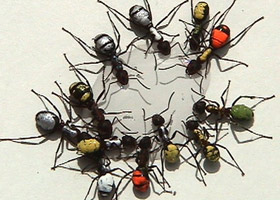

Ants used in research are painted so that researchers can keep track of individuals. This doesn't harm them! Photo: Stuart Robinson.
The life of a foraging ant involves many repeated trips between food sources and the nest. These trips are arduous and long. A single foraging trip of an ant, one of many in a day, might be hundreds of metres. We can put this in human terms by comparing this foraging distance to the body-length of an ant. A 200m journey for an ant represents a distance of over 26,000 body lengths. For a human of average height that would equate to a trip of 30 miles. An ant forager will repeat this journey until she drops dead from exhaustion.
The foraging trips aren't just long, they also follow complex zig-zag paths. So how do ants manage to find their way back home? And how do they manage to do so along a straight line? Their secret lies in ... vector geometry!
To find out more, read Finding your way home without knowing where you are.
Return to the Plus advent calendar 2019.